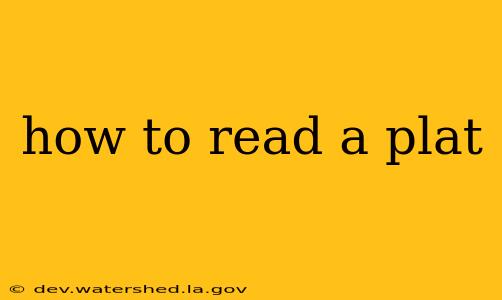A plat is a crucial document for anyone involved in real estate. It's a detailed map showing the boundaries of a piece of land, along with its features and improvements. Understanding how to read a plat is essential for property owners, real estate agents, contractors, and anyone else working with land transactions. This guide will break down the process, answering common questions and offering helpful tips.
What is a Plat and Why is it Important?
A plat, also known as a property survey map, is a formal drawing showing the location and boundaries of a piece of property. It's created by a licensed surveyor and is a legal document, often required for property transactions like buying, selling, or developing land. Its importance lies in:
- Defining Property Boundaries: The plat clearly shows where your property begins and ends, preventing future boundary disputes with neighbors.
- Identifying Improvements: It details structures like houses, barns, fences, and other significant features on the land.
- Showing Easements and Rights-of-Way: The plat highlights any easements (rights granted to others to use your property for specific purposes, like utility lines) or rights-of-way (paths or roads across your property).
- Facilitating Legal Transactions: It's a necessary document for legal transactions involving the property, providing crucial information for lenders, title companies, and other involved parties.
Key Elements Found on a Plat
Understanding the common elements on a plat is the first step to successfully interpreting it. Let's examine some key components:
- Legal Description: This is a precise description of the property's location, using metes and bounds (distance and direction) or lot and block numbers (referencing a subdivision plat). This is crucial for legal identification.
- Scale: The plat will indicate its scale, showing the ratio between the map's dimensions and the actual land dimensions (e.g., 1 inch = 50 feet).
- North Arrow: This arrow indicates the direction of north, essential for orientation and understanding the property's location relative to other features.
- Boundary Lines: These lines delineate the perimeter of the property. They are often clearly marked and may include bearing and distance measurements.
- Improvements: Buildings, fences, driveways, and other structures are usually depicted on the plat, often with their approximate dimensions.
- Easements and Rights-of-Way: These are clearly marked and usually labeled, indicating their purpose and location.
- Adjacent Property Owners: The names or parcel numbers of neighboring properties are often included.
- Surveyor's Seal and Signature: A licensed surveyor's seal and signature certify the accuracy and authenticity of the plat.
How to Read a Plat: A Step-by-Step Guide
- Identify the Legal Description: Find the legal description – this is the most critical piece of information.
- Note the Scale: Understand the scale to accurately measure distances on the plat.
- Orient Yourself Using the North Arrow: Locate the north arrow to correctly interpret the directions and positions of features on the land.
- Trace the Property Boundaries: Carefully examine the boundary lines to determine the property's exact shape and size.
- Identify Improvements: Locate and examine all improvements shown on the plat, noting their locations and approximate sizes.
- Locate Easements and Rights-of-Way: Identify any easements or rights-of-way affecting the property.
- Examine Adjacent Properties: Note the details of neighboring properties.
- Check the Surveyor's Seal and Signature: Ensure the plat is properly certified.
Common Questions about Reading Plats
What are metes and bounds descriptions?
Metes and bounds descriptions use distances (metes) and directions (bounds) to define a property's boundaries. They start at a specific point and follow a series of directions and distances to trace the entire perimeter. They're commonly used for irregularly shaped properties.
What are lot and block descriptions?
Lot and block descriptions refer to a specific lot within a recorded subdivision plat. This method is simpler than metes and bounds, using a lot number and block number to identify the property within a larger development.
Can I interpret a plat myself, or do I need professional help?
While this guide provides basic understanding, interpreting complex plats might require professional help from a surveyor or real estate attorney, especially when dealing with legal issues or potential boundary disputes.
Where can I find a plat for my property?
Plats are typically recorded with the county recorder's office or a similar local government agency. You might need to search their records using your property's legal description or address.
Reading a plat is a valuable skill for anyone involved in real estate. While the process may seem initially complex, understanding the key components and following a systematic approach will enable you to confidently interpret this crucial document. Remember to consult with a professional if you encounter any ambiguities or complexities.
